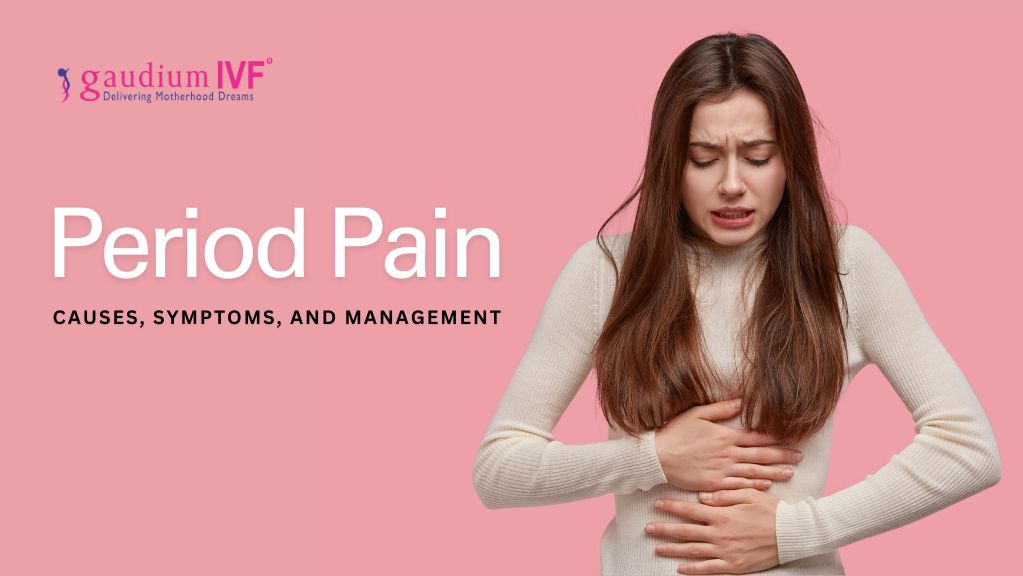Introduction:
Period pain, commonly known as menstrual cramps or Dysmenorrhea, is a prevalent gynecological condition characterized by painful menstruation. It affects individuals of reproductive age and can significantly impact daily activities and quality of life. With Gaudium IVF, the best IVF center in Mumbai we will understand the causes, symptoms, and management strategies for Period pain.
Types of Period pain:
1. Primary Dysmenorrhea: Primary dysmenorrhea occurs without any underlying reproductive disorders and typically begins within a few years of the onset of menstruation. It is caused by increased levels of prostaglandins, hormone-like substances that promote uterine contractions, leading to cramping pain.
2. Secondary Dysmenorrhea: Secondary Dysmenorrhea associated with underlying medical conditions such as endometriosis, adenomyosis, pelvic inflammatory disease (PID), or uterine fibroids. The pain associated with secondary dysmenorrhea often worsens over time and may be accompanied by other symptoms such as abnormal bleeding or pelvic pain outside of menstruation.
Causes of Period pain:
1. Prostaglandin Release: During menstruation, the uterus produces prostaglandins, which trigger uterine muscle contractions to expel the uterine lining. Elevated levels of prostaglandins can lead to stronger and more painful contractions, resulting in Period pain.
2. Hormonal Imbalance: Fluctuations in hormone levels, particularly estrogen and progesterone, can contribute to Period pain. Imbalances in these hormones can affect the menstrual cycle and increase sensitivity to pain.
3. Underlying Reproductive Disorders: Conditions such as endometriosis, adenomyosis, pelvic inflammatory disease (PID), or uterine fibroids can cause secondary dysmenorrhea by affecting the structure and function of the reproductive organs.
4. Pelvic Congestion: Increased blood flow to the pelvic area during menstruation can lead to pelvic congestion, causing pressure and pain.
Symptoms of Period pain:
1. Cramping Pain: The hallmark symptom of dysmenorrhea is cramping pain in the lower abdomen that may radiate to the lower back and thighs. The pain can range from mild to severe and may interfere with daily activities.
2. Nausea and Vomiting: Some individuals with Period pain may experience nausea, vomiting, or diarrhea during menstruation, particularly when the pain is severe.
3. Fatigue: Period pain can cause fatigue and tiredness due to the body's response to pain and hormonal changes.
4. Headaches: Headaches or migraines may occur as a result of hormonal fluctuations and increased sensitivity to pain during menstruation.
Management of Period pain:
1. Over-the-Counter Medications: Non-steroidal anti-inflammatory drugs (NSAIDs) such as ibuprofen can help alleviate pain and inflammation associated with Period pain. These medications work by inhibiting prostaglandin production.
2. Heat Therapy: Applying heat to the lower abdomen or lower back can provide relief from menstrual cramps by relaxing the uterine muscles and reducing pain.
3. Exercise: Engaging in regular physical activity, such as walking, swimming, or yoga, can help reduce the severity of Period pain by promoting blood circulation.
4. Relaxation Techniques: Practicing relaxation techniques such as deep breathing or meditation can help alleviate stress and reduce muscle tension, providing relief from Period pain.
5. Hormonal Contraceptives: Hormonal contraceptives, including birth control pills or patches can help regulate menstrual cycles and reduce pain associated with Periods by suppressing ovulation and decreasing prostaglandin levels.
Conclusion:
Period pain is a common gynecological condition characterized by painful menstruation that can significantly impact daily life. By understanding the causes, symptoms, and management strategies for Period pain, individuals can effectively alleviate pain and improve their quality of life during menstruation. It's essential to consult the best Infertility specialist in Mumbai for accurate diagnosis and personalized treatment recommendations tailored to individual needs and preferences. With the right approach, Period pain can be effectively managed, allowing individuals to live comfortably and confidently.
Source: https://fertilityivf.weebly.com/home/understanding-period-pain-causes-symptoms-and-management






Comments